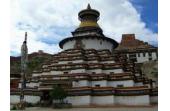Shigatse, also named Xigatse, means 'the fertile land'. Covering an
area of over 3875 square kilometers (about 1496 square miles), this
frontier city is the second largest in Tibet. It sits in the plain
at the confluence of the Yarlong Tsangpo and Nyangchu Rivers, where
Tibet's most fertile land is to be found. With some thirteen ethnic
groups including Tibetan, Hui and Man, Shigatse is a typical living
area for minority nationalities. The population of Shigatse City is
98,700 about 97% of which are Tibetan. Shigatse has a history going
back more than 600 years and it is this ancient holy city that is
the traditional seat of the Panchen Lama, one of the spiritual
leaders in Tibet. The city is also the cultural, economic and
political center of Tibet.
Before the 1950s, Shigatse remained in a primitive state in terms
of its economy and its people's lifestyle. Following reformation
and the opening up to the modern world, a series of highways were
built up such as the Shigatse is one of the world's highest
cities with beautiful high plateau scenery. It is also a hot
spot for Chinese tourism. The average elevation here is in a range
of 3840 meters (about 12598.4 feet) - 4464 meters (about 14645.7
feet), which endows cool and even cold weather to the area. In the
high plateau, the climate is not very pleasant due to the frequent
wind and dry atmosphere. However, it is not bad a place for
summering. Its long history gives this city a strong cultural
heritage, especially in respect of Buddhism. The approximately 600
year-old majestic Tashilhunpo Monastery has a magnificent
architectural style with a golden roof and resplendent buildings.
Dozens of monasteries belonging to different sects enhance the
atmosphere of Buddhism. Various grand festivals like Buddha
Unveiling Festival in the monasteries each year give people a
chance to admire the huge portraits of three Buddhas.
Shigatse is of great importance for its location in this area. It
is 300 kilometers (about 186 miles) away from the world's highest
peak Mt. Everest, 150 kilometers (about 93 miles) away from the
Sakya Monastery and also on the only path to Tibet's holy lakes.
Thus Shigatse is quite an important base for people heading for
those places. In the city, hotels and motels of different
classifications satisfy tourists' needs. Although
the accommodation in this remote area cannot be compared with
those in modern cities, they are still important and plentiful. In
terms of transportation, there are tourist buses heading for the
nearby venues such as Lhasa, Zhangmu and Nakchu. Public amenities
such as the post office and banks do much to facilitate travel in
Tibet.
No.318 National Highway and the China-Nepal Highway. These connect
Shigatse with the outside world while opening up the outside world
to people in Shigatse.
Nowadays, Shigatse is an important Tibetan communication hub and an
air of modernization pervades the area. New industries including
mechanics, chemicals and food production thrive here. Meanwhile,
the traditional handcrafts have been encouraged and expanded.
Products such as Tibetan knives as well as items of silver and gold
are sought after throughout China and are exported abroad.
Recommended Tours including the Visit to Shigatse:
Tibet Adventure Tour: 16 Days of Hong Kong - Guangzhou - Lhasa
- Gyangtse - Shigatse - Lhasa - Xian – Beijing
Related Hiking Tour Itineraries Information:
Shigatse Tour: 2-day Shigatse Tour
Shigatse Discovery: 3-Day Shigatse In-depth Exploration
Shigatse Exploration: 2 Days Monastery Tours in Shigatse











